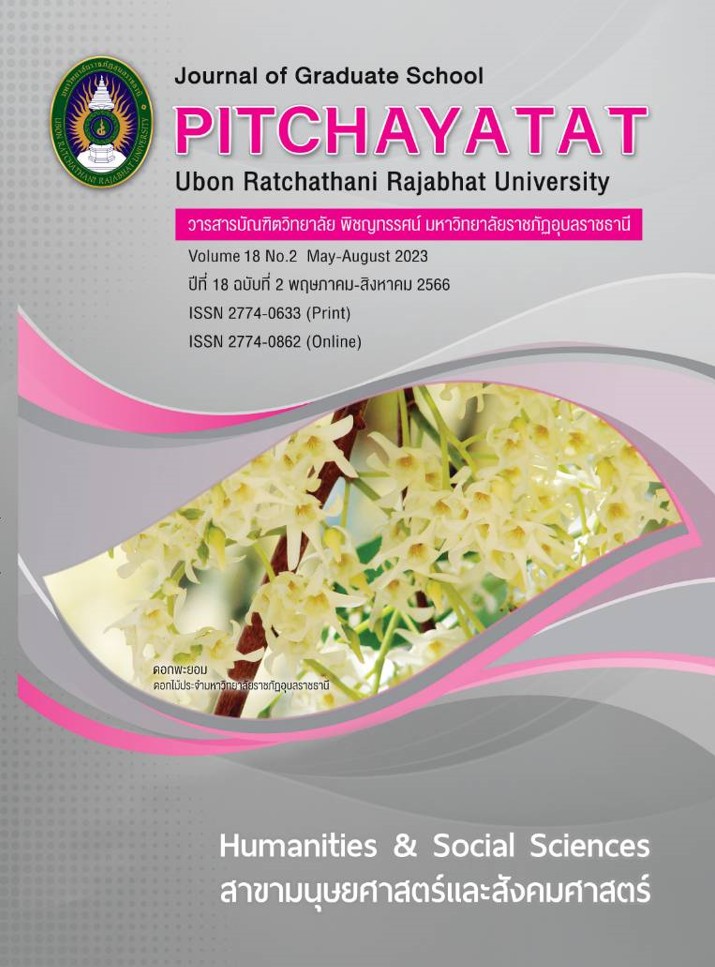การศึกษาความเข้าใจในมโนมติทางวิทยาศาสตร์ เรื่องสารละลายของนักเรียนระดับชั้นมัธยมศึกษาปีที่ 4 โดยใช้กิจกรรมการเรียนรู้แบบทำนาย สังเกต อธิบาย
คำสำคัญ:
มโนมติทางวิทยาศาสตร์, กิจกรรมการเรียนรู้, สารละลายบทคัดย่อ
การวิจัยนี้มีวัตถุประสงค์เพื่อ 1) เปรียบเทียบผลสัมฤทธิ์ทางการเรียนวิชาเคมี เรื่องสารละลาย 2) ศึกษาความเข้าใจในมโนมติทางวิทยาศาสตร์ เรื่องสารละลาย ของนักเรียนชั้นมัธยมศึกษาปีที่ 4 โดยใช้กิจกรรมการเรียนรู้แบบทำนาย สังเกต อธิบาย ตัวอย่างที่ใช้ ได้แก่ นักเรียนชั้นมัธยมศึกษาปีที่ 4/3 ห้องแผนการเรียนคณิตศาสตร์และวิทยาศาสตร์ โรงเรียนนารีนุกูล จังหวัดอุบลราชธานี ภาคเรียนที่ 2 ปีการศึกษา 2565 จำนวน 36 คน ซึ่งได้มาโดยวิธีการสุ่มแบบกลุ่ม เครื่องมือที่ใช้ ได้แก่ 1) แผนการจัดการเรียนรู้วิชาเคมี เรื่องสารละลาย ระดับชั้นมัธยมศึกษาปีที่ 4 จำนวน 16 แผน 2) แบบทดสอบวัดผลสัมฤทธิ์ทางการเรียน วิชาเคมี เรื่อง สารละลาย ระดับชั้นมัธยมศึกษาปีที่ 4 สถิติที่ใช้ ได้แก่ ร้อยละ ค่าเฉลี่ย ส่วนเบี่ยงเบนมาตรฐาน และการทดสอบที
ผลการศึกษาพบว่า
- ผลสัมฤทธิ์ทางการเรียนวิชาเคมี เรื่อง สารละลาย ของนักเรียนชั้นมัธยมศึกษาปีที่ 4 โดยใช้กิจกรรมการเรียนรู้แบบทำนาย สังเกต อธิบาย หลังเรียนสูงกว่าก่อนเรียนอย่างมีนัยสำคัญทางสถิติที่ระดับ .05
- จำนวนนักเรียนตามกลุ่มความเข้าใจมโนมติทางวิทยาศาสตร์ คือ กลุ่มที่ไม่สามารถระบุความเข้าใจมโนมติ (NR) กลุ่มความเข้าใจมโนมติผิด (MU) กลุ่มความเข้าใจมโนมติคลาดเคลื่อน (AU) และกลุ่มความเข้าใจมโนมติถูกต้อง (SU) ก่อนเรียน คือ 12, 18, 5 และ 1 ตามลำดับ และหลังเรียน คือ 0, 0, 15, และ 21 ตามลำดับ และจำนวนนักเรียนที่มีความเข้าใจมโนมติระหว่างเรียนเพิ่มขึ้น เฉลี่ยรวมร้อยละ 18.40
เอกสารอ้างอิง
ชำนาญ เพริดพราว และโชคชัย ยืนยง. “การศึกษามโนมติเรื่องฟิสิกส์อะตอมของนักเรียนชั้นมัธยมศึกษาปีที่ 5 โดยใช้วิธีการสอนแบบเปรียบเทียบ,” วารสารวิจัย มข. 12, 3 (กรกฎาคม-กันยายน 2555): 138-147.
ณริศรา อรรฆยมาศ. “ผลการจัดกิจกรรมการเรียนรู้โดยใช้เทคนิคทำนาย สังเกต อธิบาย ร่วมกับการใช้แผนภาพ (Predict-Observe-Explain-Mapping: POEM) ที่มีต่อผลสัมฤทธิ์ทางการเรียนวิชาเคมี และทักษะการคิดวิเคราะห์ ของนักเรียนชั้นมัธยมศึกษาปีที่ 5,” วารสารศึกษาศาสตร์ มหาวิทยาลัยสงขลานครินทร์ วิทยาเขตปัตตานี. 1, 27 (กรกฎาคม-ธันวาคม 2559): 89-99.
ทดสอบทางการศึกษาแห่งชาติ, สถาบัน. สรุปผลการทดสอบการศึกษาระดับชาติขั้นพื้นฐาน (O-NET) ปีการศึกษา 2563. (ออนไลน์) 2564 (อ้างเมื่อ 19 พฤษภาคม 2565). จาก www.onetresult.niets.or.th
ทดสอบทางการศึกษาแห่งชาติ, สถาบัน. สรุปผลการทดสอบการศึกษาระดับชาติขั้นพื้นฐาน (O-NET) ปีการศึกษา 2564. (ออนไลน์) 2565 (อ้างเมื่อ 19 พฤษภาคม 2565). จาก www.onetresult.niets.or.th.
ไผ่ พันงาม. การพัฒนาความเข้าใจมโนมติวิทยาศาสตร์ เรื่อง สารละลาย ด้วยวัฏจักรการเรียนรู้แบบสืบเสาะ 5 ขั้น ผสมผสานกับเทคนิคทำนาย-สังเกต-อธิบาย ในขั้นสร้างความสนใจ สำหรับนักเรียนชั้นมัธยมศึกษาปีที่ 1. วิทยานิพนธ์วิทยาศาสตรมหาบัณฑิต มหาวิทยาลัยอุบลราชธานี, 2560.
พนิตานันท์ วิเศษแก้ว และน้อยทิพย์ ลิ้มยิ่งเจริญ. “การพัฒนามโนมติทางวิทยาศาสตร์ เรื่อง แรงและความดันของนักเรียนชั้นประถมศึกษาปีที่ 5 โดยใช้การสอนแบบ Predict-Observe-Explain (POE),” วารสารศึกษาศาสตร์มหาวิทยาลัยขอนแก่น. 4, 3 (กรกฎาคม-กันยายน 2553): 61-67.
พิชา ชัยจันดี. ความเข้าใจมโนมติทางวิทยาศาสตร์เรื่องการสังเคราะห์ด้วยแสงของนักเรียนชั้นมัธยมศึกษาปีที่ 5 เมื่อใช้ยุทธศาสตร์การสอนเพื่อปรับเปลี่ยนมโนมติและความสัมพันธ์ระหว่างความเชื่อเกี่ยวกับแรงจูงใจกับการเปลี่ยนแปลงมโนมติ. วิทยานิพนธ์ศึกษาศาสตรมหาบัณฑิตมหาวิทยาลัยขอนแก่น, 2552.
โรงเรียนนารีนุกูล. รายงานผลสัมฤทธิ์ทางการเรียนวิชาวิทยาศาสตร์ โรงเรียนนารีนุกูล สำนักงานเขตพื้นที่การศึกษามัธยมศึกษาอุบลราชธานี อำนาจเจริญ. อุบลราชธานี: โรงเรียนนารีนุกูล, 2565.
ศึกษาธิการ, กระทรวง. ตัวชี้วัดการเรียนรู้แกนกลาง กลุ่มสาระการเรียนรู้วิทยาศาสตร์ (ฉบับปรับปรุง พ.ศ. 2560) ตามหลักสูตรแกนกลางการศึกษาขั้นพื้นฐาน พุทธศักราช 2551. กรุงเทพฯ: ชุมนุมการเกษตรแห่งประเทศไทย, 2560.
ดาวน์โหลด
เผยแพร่แล้ว
รูปแบบการอ้างอิง
ฉบับ
ประเภทบทความ
สัญญาอนุญาต
ลิขสิทธิ์ (c) 2023 วารสารบัณฑิตวิทยาลัย พิชญทรรศน์ มหาวิทยาลัยราชภัฏอุบลราชธานี

อนุญาตภายใต้เงื่อนไข Creative Commons Attribution-NonCommercial-NoDerivatives 4.0 International License.
บทความทุกเรื่องได้รับการตรวจความถูกต้องทางวิชาการโดยผู้ทรงคุณวุฒิภายนอกอย่างน้อย 2 คน ความคิดเห็นในวารสารบัณฑิตวิทยาลัย พิชญทรรศน์ มหาวิทยาลัยราชภัฏอุบลราชธานี เป็นความคิดเห็นของผู้เขียนมิใช่ความคิดเห็นของผู้จัดทำ จึงมิใช่ ความรับผิดชอบของบัณฑิตวิทยาลัย มหาวิทยาลัยราชภัฏอุบลราชธานี และบทความในวารสารบัณฑิตวิทยาลัย พิชญทรรศน์ มหาวิทยาลัยราชภัฏอุบลราชธานี สงวนสิทธิ์ตามกฎหมายไทย การจะนำไปเผยแพร่ต้องได้รับอนุญาตเป็นลายลักษณ์อักษรจากกองบรรณาธิการ






